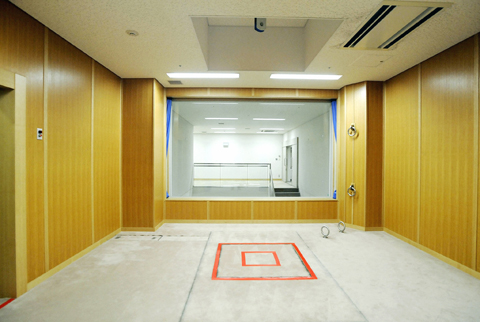Japan opened up its gallows for the first time to domestic media yesterday, a move that could spark public debate over executions in a country where a hefty majority supports retaining the death penalty.
The media tour at the Tokyo Detention Center — broadcast on major TV stations — appears to be driven by Japanese Justice Minister Keiko Chiba, who opposes the death penalty.
In July, Chiba approved — and witnessed — the hangings of two inmates convicted of murder, saying she was carrying out her duties as justice minister.

PHOTO: REUTERS/KYODO
Afterward, Chiba said she still supports abolishing capital punishment, and as a way to spur public debate, ordered that journalists be given a tour of the facilities, which Japanese press said was the first since at least the end of World War II. She also promised to create a ministry panel to discuss the death penalty, including whether it should be stopped.
TV footage from inside the Tokyo Detention Center showed the trap door, the viewing room and rooms where the inmate can meet with a cleric, with a Buddhist altar and a Buddha statue. The trap door was closed and the rope was not exhibited.
“There was the smell of incense ... The impression was that of sterile objects in a clean, carpeted room,” said a reporter from broadcaster NTV, among those taken to the prison in a bus, its windows obscured by curtains to hide the chamber’s location.
Footage also showed the “button room,” where three prison officers press a button at the same time to open the trap door, so that it is not clear which button opened the door.
Japan, along with the US, is one of only two G8 countries that retain capital punishment. It currently has 107 inmates on death row.
An overwhelming majority supports the death penalty in Japan. Last year, 86 percent said in a government survey that retaining the death penalty was unavoidable, up from 80 percent in 1999, though a recent NHK public TV survey put support at 57 percent.
Experts say they are concerned over how little the public knows about the death penalty despite a new lay judge system from last year under which ordinary citizens, along with judges, could hand down such sentences.
Japan has been criticized by the UN Committee against Torture and opponents of the death penalty over the secrecy of its execution system and the psychological strain it puts on inmates and their families.
“There will be no small impact from opening up the site of executions, until now shrouded in a thick veil,” Kyodo news agency said.
“It is fully possible that this will spark public debate over whether to maintain or abolish the system, as hoped for by the justice minister,” Kyodo said.
Inmates are notified on the morning of the execution, usually about an hour beforehand, and families of inmates are given no advance notification, experts say.
The Japanese Justice Ministry in 2007 started releasing the names and crimes of inmates sentenced to death.
Details on executions had previously been strictly limited and opponents of the death penalty say the ministry still restricts information.

A Philippine boat convoy bearing supplies for Filipino fishers yesterday said that it was headed back to port, ditching plans to sail to a reef off the Southeast Asian country after one of their boats was “constantly shadowed” by a Chinese vessel. The Atin Ito (“This Is Ours”) coalition convoy on Wednesday set sail to distribute fuel and food to fishers and assert Philippine rights in the disputed South China Sea. “They will now proceed to the Subic fish port to mark the end of their successful mission,” the group said in a statement. A Philippine Coast Guard vessel escorting the convoy was

DISPUTED WATERS: The Philippines accused China of building an artificial island on Sabina Shoal, while Beijing said Manila was trying to mislead the global community The Philippine Coast Guard (PCG) is committed to sustaining a presence in a disputed area of the South China Sea to ensure Beijing does not carry out reclamation activities at Sabina Shoal (Xianbin Reef), its spokesperson said yesterday. The PCG on Saturday said it had deployed a ship to Sabina Shoal, where it accused China of building an artificial island, amid an escalating maritime row, adding two other vessels were in rotational deployment in the area. Since the ship’s deployment in the middle of last month, the PCG said it had discovered piles of dead and crushed coral that had been dumped

Experts have long warned about the threat posed by artificial intelligence (AI) going rogue, but a new research paper suggests it is already happening. AI systems, designed to be honest, have developed a troubling skill for deception, from tricking human players in online games of world conquest to hiring humans to solve “prove-you’re-not-a-robot” tests, a team of researchers said in the journal Patterns on Friday. While such examples might appear trivial, the underlying issues they expose could soon carry serious real-world consequences, said first author Peter Park, a postdoctoral fellow at the Massachusetts Institute of Technology specializing in AI existential safety. “These

The most powerful solar storm in more than two decades struck Earth on Friday, triggering spectacular celestial light shows from Tasmania to the UK — and threatening possible disruptions to satellites and power grids as it persists into the weekend. The first of several coronal mass ejections (CMEs) — expulsions of plasma and magnetic fields from the sun — came just after 4pm GMT, according to the US National Oceanic and Atmospheric Administration’s Space Weather Prediction Center. It was later upgraded to an “extreme” geomagnetic storm — the first since the “Halloween Storms” of October 2003 caused blackouts in Sweden and damaged